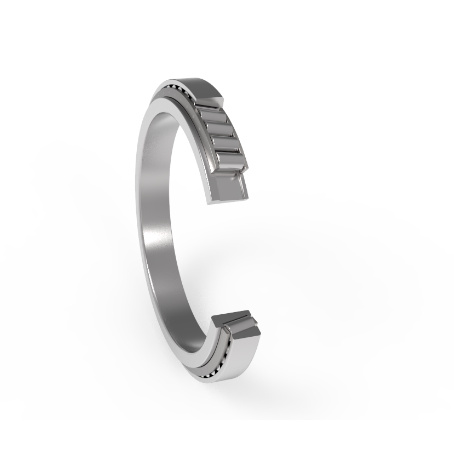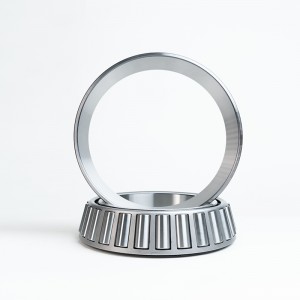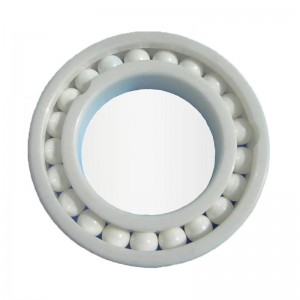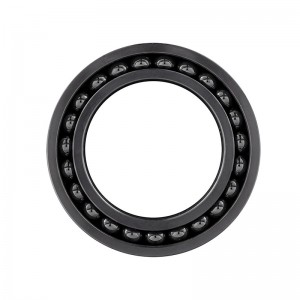Single Row Tapered Roller Bearings Metric System ( Inch System )
product features:
The inner and outer rings of tapered roller bearings have tapered raceways, and tapered rollers are installed between the raceways. If the tapered surface is extended, it will eventually converge to a point on the bearing axis. Tapered roller bearings are mainly used to bear radial and axial combined loads mainly based on radial loads. The axial load carrying capacity of the bearing is determined by the contact angle. The larger the axial load carrying capacity, the higher the axial load carrying capacity. The tapered roller bearing is a separable bearing, that is, the inner ring, the roller and the cage are combined into an independent component, which can be separated from the outer ring. Install.
This kind of bearing can limit the axial displacement of one side of the shaft or the casing, and does not allow the shaft to be inclined relative to the casing hole. Under the action of radial load, additional axial force will be generated. Therefore, generally in the two bearings of the bearing, the outer ring and inner ring of the bearing should be installed opposite to each end face.
The single row tapered roller can only limit the axial displacement of the shaft or housing in one direction, and bear the axial load in one direction. Under the action of radial load, the axial force generated in the bearing must also be balanced. Both bearings should be mounted face to face or back to back.
Application:
Such bearings are mainly used in automobile front wheels, rear wheels, transmissions, differentials, pinion shafts, machine tool spindles, construction machinery, large agricultural machinery, railway vehicles, gear reduction devices, and rolling mill roll neck small reduction devices.

Size range:
Inner diameter size range: 20mm~1270mm
Outer diameter size range: 42mm~1465mm
Width size range: 15mm~240mm
Tolerance: Metric tapered roller bearings have general tolerances, and can also provide P6X, P6, P5, P4, P2 tolerance products,
Inch tapered roller bearings have general tolerances, and CL2, CL3, CLO, CL00 tolerance products are also available upon request.
cage
Tapered roller bearings generally use a steel stamped basket cage, but when the size is larger, a car-made solid pillar cage is also used.
Prefix:
In F inch tapered roller bearings, add "F" before the bearing series number, indicating the bearing cage
G In inch tapered roller bearings, it means the bearing inner spacer or outer spacer
Inner spacer representation method: add "G-" before the component code of the inch series bearing
In K inch tapered roller bearings, the bearing rings and rolling elements or only the rings are made of high carbon chromium bearing steel
In K1 inch tapered roller bearings, the bearing rings and rolling elements or only the rings are made of 100CrMo7
In K2 inch tapered roller bearings, the bearing rings and rolling elements or only the rings are made of ZGCr15
R In inch tapered roller bearings, add "R" before the bearing series number to indicate tapered rollers
Postcode:
A: 1. For tapered roller bearings, the contact angle a and the outer ring raceway diameter D1 are inconsistent with the national standard. If there are two or more types of a and D1 different from the national standard in the code, use A and A1 in turn. A2... indicates.
2. Outer ring guide.
A6 inch tapered roller bearing assembly chamfer is inconsistent with TIMKEN. When there are two or more different dry TIMKEN assembly chamfers in the same code, they are represented by A61 and A62.
B tapered roller bearings, the contact angle is increased (increase an angle series).
C paired with tapered roller bearings, when the axial clearance does not meet the standard requirements, the average value of the axial clearance is directly added behind C.
/CR paired with tapered roller bearings, when there is a requirement for radial clearance, the average value of radial clearance is added behind CR.
/DB Two tapered roller bearings for back-to-back mounting in pairs
/DBY Two single row tapered roller bearings for back-to-back mounting, with inner spacer and without outer spacer.
/DF Two tapered roller bearings for face-to-face pair mounting
/HA ring rolling elements and cages or just the rings and rolling elements are made of vacuum smelted bearing steel.
/HC ferrules and rolling elements or only the ferrules or only the rolling elements are made of carburized steel (/HC-20Cr2Ni4A;/HC1-20Cr2Mn2MoA;/HC2-15Mn;/HC3-G20CrMo)
/HCE If it is a metric bearing, it means that the rings and rolling elements are high-quality carburized steel.
/HCER means if only the rollers in the metric bearing are high quality carburized steel.
/HCG2I means that the outer ring and rolling elements are made of carburized steel, and the inner ring is made of GCr18Mo.
/HCI indicates that the inner ring is made of carburized steel.
/HCO indicates that the outer ring is made of carburized steel.
/HCOI means that only the outer ring and inner ring are made of carburized steel.
/HCOR indicates that the outer ring and rolling elements are made of carburized steel.
/HCR: Indicated to distinguish the same specification, only the rolling elements are made of carburized steel.
/HE ring rolling elements and cages or only the rings and rolling elements are made of electroslag remelted bearing steel (military steel)
/HG: Made by ZGCr15.
Rings and rolling elements or just rings are made of other bearing steels (/HG-5GrMnMo;/HG1-55SiMoVA;/HG2-GCr18Mo;/HG3-42CrMo;/HG4-GCr15SiMn).
/HG2CR means that the ferrule is made of GCr18Mo, and the rolling elements are made of carburized steel.
If /HG2 is a radial bearing, it means that the inner ring is made of GCr18Mo, and the outer ring and rolling elements are made of GCr15;
/HG20 indicates that the outer ring is made of GCr18Mo.
The /HN sleeve is made of heat-resistant (/HN-Cr4Mo4V;/HN1-Cr14Mo4;/HN2-Cr15Mo4V;/HN3-W18Cr4V).
/HP Rings and rolling elements are made of beryllium bronze or other anti-magnetic materials. When the material is changed, additional numbers are indicated.
/HQ rings and rolling elements are made of less commonly used materials (/HQ-plastic; /HQ1-ceramic alloy).
/HU Ring rolling elements and cages or just the rings and rolling elements are made of non-hardenable stainless steel 1Cr18Ni9Ti.
/HV ring rolling elements and cages or just the rings and rolling elements are made of hardenable stainless steel (/HV-9
K taper bore bearing, taper 1:12.
K30 tapered bore bearing, taper 1:30.
P bearing accuracy grade, followed by a number to represent the specific accuracy grade
R bearing outer ring has stop rib (flange outer ring)
-RS bearing has a skeleton rubber seal (contact type) on one side.
The RS1 bearing has a skeleton rubber sealing ring (contact type) on one side, and the sealing ring material is vulcanized rubber.
-RS2 bearing has a skeleton rubber sealing ring (contact type) on one side, and the sealing ring material is fluorinated rubber.
-2RS Bearings with RS seals on both sides.
-2RS1 Bearings with RS1 seals on both sides.
-2RS2 Bearings with RS2 seals on both sides
RZ bearing with skeleton rubber seal on one side (non-contact type)
-2RZ bearings with RZ seals on both sides
S martensitic quenching.
/SP super precision grade, the dimensional tolerance is equivalent to grade 5, and the rotation accuracy is equivalent to grade 4.
/S0 bearing rings are tempered at high temperature, and the working temperature can reach 150 ℃.
The /S1 bearing ring is tempered at high temperature, and the working temperature can reach 200 ℃.
The /S2 bearing ring is tempered at high temperature, and the working temperature can reach 250 ℃.
/S3 bearing rings are tempered at high temperature, and the working temperature can reach 300 ℃.
The /S4 bearing ring is tempered at high temperature, and the working temperature can reach 350 ℃.
sC Covered radial bearing.
When the fitting height dimension of the T paired tapered roller bearing does not meet the standard requirements, the fitting height dimension is directly attached to the back of the T.
V full complement of rolling elements (without cage)
X1 full complement of rolling elements (without cage)
X2 outside diameter is non-standard.
X3 width (height) is non-standard.
X4 outer diameter, width (height) non-standard (standard inner diameter) inner diameter rounding non-standard bearings, when the inner diameter size is non-integer, and there are two or more decimal places, use X4 table
Show rounding.
-XRS four-row tapered roller bearing with multiple seals (more than two seals)
Y: Y and another letter (eg YA, YB) or a combination of numbers are used to identify non-sequential changes that cannot be expressed by the existing postfix. YA structure changes.
The outer surface of the YA1 bearing outer ring is different from the standard design.
The inner hole of the inner ring of the YA2 bearing is different from the standard design.
The end face of the YA3 bearing ring is different from the standard design.
The raceway of YA4 bearing ring is different from the standard design.
YA5 bearing rolling elements differ from the standard design.
The YA6 bearing assembly chamfer is different from the standard design.
The YA7 bearing rib or ring is different from the standard design.
YA8 cage structure changed.
The contact angle of the YA9 bearing is different from the standard design (angular contact bearing).
YA10 double row tapered roller bearings, there are oil grooves and oil holes on the inner spacer or the size of the spacer is changed.
The YAB structure changes at the same time as the technical requirements.
YAD The same type of bearing, the structure has more than two changes at the same time.
YB technical requirements change.
The YB1 bearing ring has a coating on the surface.
YB2 bearing size and tolerance requirements changed.
The surface roughness requirements of YB3 bearing rings are changed.
YB4 Heat treatment requirements (eg hardness) changed.
YB5-bit tolerance has special requirements.
YBD bearing of the same type, the technical requirements have more than two changes at the same time.
-Z bearing has a dust cover on one side.
-2Z bearing has dust cover on both sides.








